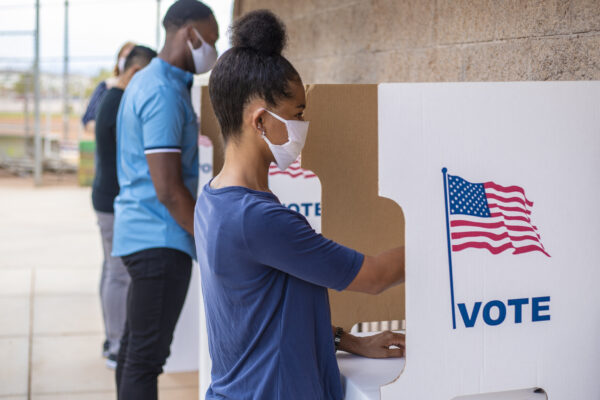The Supreme Court has blocked the creation of a new Black-majority congressional district in Alabama. The decision aligns the justices with the state’s Republicans, who claim creating the new district would put too much of an emphasis on race during elections.

On Monday, Feb. 7, the highest court in the country voted 5-4 in the controversial Merrill v. Milligan case. The vote will maintain, as is, the recently updated Alabama voting map despite it not accurately reflecting the change in the state’s racial make-up.
The current way the state is lined for districting, many civil rights activists and a lower court said that it disenfranchises people of color.
Still, five of the conservative justices, all appointed by Republicans, voted to block the order from the lower court that required a new map be created that would allow an additional all-Black district to be created. This would be in alignment with provisions made to ensure voter fairness in the late 1960s.
With this vote, the justices also prohibited any opportunity for this legal issue to be heard before the court’s new term in the fall.
This is not the first time this issue has come before the Supreme Court. In November of 2021, NBC News reports, based on the data collected in the 2020 census, the issue of redrawing the district lines and political boundaries emerged as a topical issue. The results reflected that the “Heart of Dixie’s” Black population had grown by 4 percent. The demographics for whites in the state changed also, declining by 2 percent.
The census shows that now Blacks make up 27 percent of the state’s total population but have only a voting majority in one of its seven congressional districts.
The state’s Republican-controlled Legislature drew a new congressional district map that created only one majority-Black district, consisting of Birmingham and a few counties along the state’s western border, where their votes would come in as the majority. This would be the 7th District.
A lower court made up of three judges — one judge appointed by Bill Clinton and two judges appointed by Donald Trump — ruled that by keeping the new redistricting map Alabama is likely to violate the federal Voting Rights Act and weaken the opportunities for Black voters to be heard.
Those judges asserted that by not creating a second district, one that reflects the census data collected two years ago, Black voters will not have an avenue to have equitable representation.
This lower court’s ruling was 200 pages.
As a result, more than a dozen mostly red states filed a brief urging the justices to side with Alabama on the matter of redrawing this district map. The Supreme Court, through the vote, took the recommendation of the Republican-led states.
In his opinion on the case, Justice Brett M. Kavanaugh said that a lower court’s decision would require the state to redraw its district lines over a matter of weeks, and would be unfair. For this reason, he voted in favor of a stay in the case of Merrill v. Milligan, insisting that his decision has nothing to do with a systemic creation of legal barriers to disenfranchise Black voters.
He stated in his argument for Merrill v. Milligan, “I concur in the Court’s stay of the District Court’s injunction. … To begin with, the principal dissent is wrong to claim that the Court’s stay order makes any new law regarding the Voting Rights Act. The stay order does not make or signal any change to voting rights law.”
Kavanaugh brings up the Voting Rights Act, a very important political issue centered on the security of all Americans’ votes, because of the recent changes in the voting laws. When the federal Voting Rights Act of 1965 was originally passed it required states with histories of racial discrimination to request permission from the Justice Department or federal courts before creating new political maps. However, in 2013, the Supreme Court voted to dissolve that requirement.
The justice, appointed by President Donald Trump in 2018, also was of the opinion it was too late in Alabama’s process to start over with an updated map.
He wrote, “Running elections state-wide is extraordinarily complicated and difficult. Those elections require enormous advance preparations by state and local officials and pose significant logistical challenges. The district court’s order would require heroic efforts by those state and local authorities in the next few weeks – and even heroic efforts likely would not be enough to avoid chaos and confusion.”
“Late judicial tinkering with election laws can lead to disruption and to unanticipated and unfair consequences for candidates, political parties, and voters, among others,” he shared.
He was joined by Justice Samuel Alito in this concurring opinion.
Four justices voted to create the new district, arguing that the GOP-drawn district map unconstitutionally dilutes that Black vote in Alabama. Three of those judges, appointed by Democrats, submitted a dissent collectively. One judge, Chief Justice John G. Roberts Jr. gave his remarks singularly.
Justice Elena Kagan crafted the dissent, one joined by Justices Stephen G. Breyer and Sonia Sotomayor, saying that the court went “badly wrong in granting a stay.” She further argued that by accepting Alabama’s dispute, they “would rewrite decades of this court’s precedents” about the protections of the Voting Rights Act.
She further wrote that the court “did everything right under the law existing today. Staying its decision forces Black Alabamians to suffer what under that law is clear vote dilution.”
“Alabama is not entitled to keep violating Black Alabamians’ voting rights just because the court’s order came down in the first month of an election year,” she opined.
“It does a disservice to Black Alabamians who under that precedent have had their electoral power diminished — in violation of a law this Court once knew to buttress all of American democracy,” she wrote.
Less than a month ago, the Freedom to Vote: John R. Lewis Act, written in part by Democratic Rep. Terri Sewell of Alabama and inspired by one of the state’s most important advocates against voter suppression, died on the U.S. Senate floor.
Despite holding the majority, Democratic Senators could not get Senate Republicans, and two Democrats, to adjust Senate rules that would allow the bill to be presented for consideration without being blocked by a Republican filibusterer.
Alabama Sens. Richard Shelby Alabama and Tommy Tuberville voted against the measure to change Senate rules, driving the nail into an act named after “The Boy from Troy” — Lewis — that marched as a freedom fighter in the 1960s for the original Voting Rights Act.
More news from our partners:


